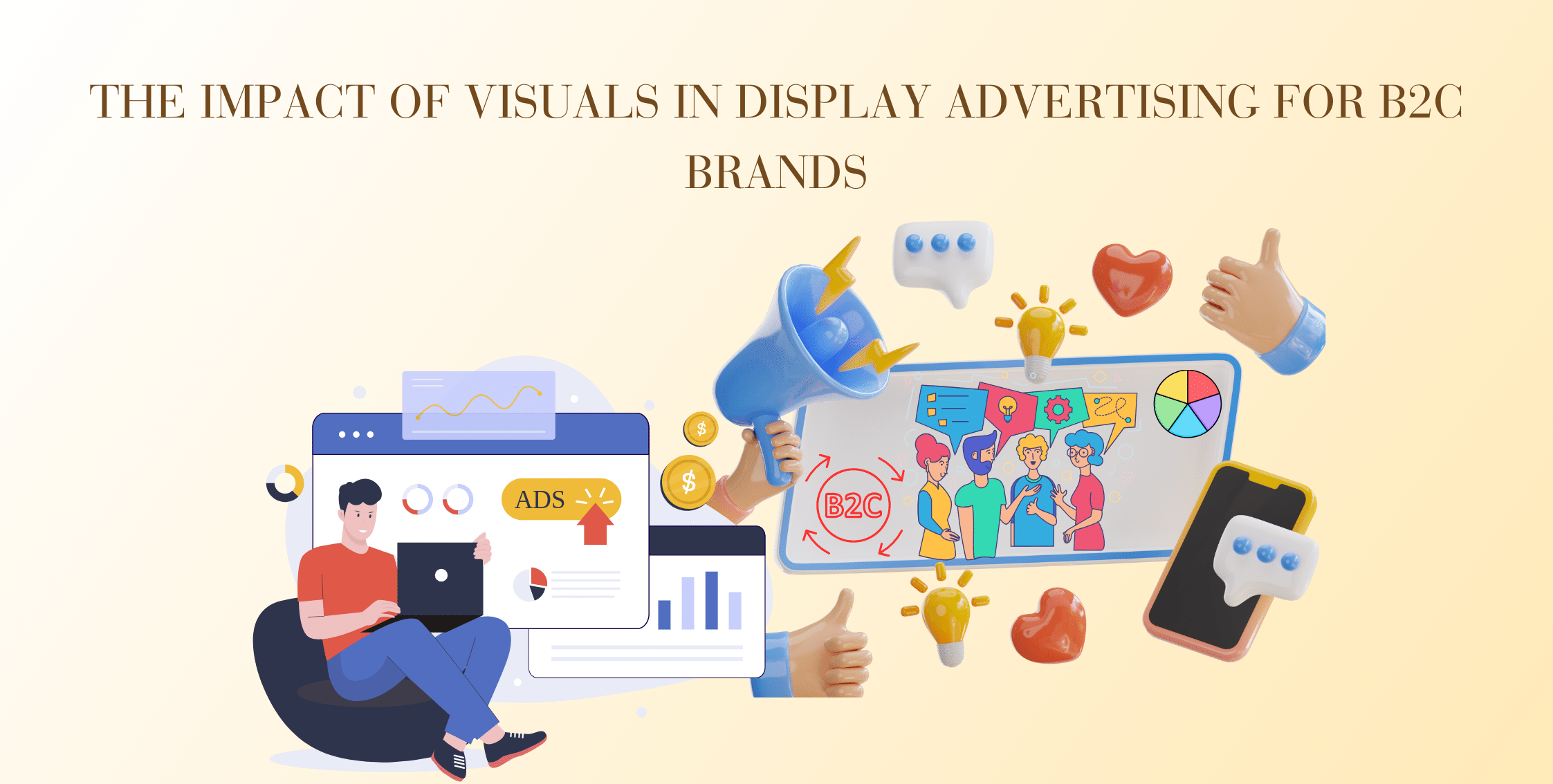Have you heard of the saying, "A picture is worth a thousand words"?
Well! it sounds like, a single image can say more than a whole bunch of words.
And you know what? It's pretty spot-on!
Think about it this way: when you see a cool picture or a video, does it stick with you longer than just reading a bunch of words?
That's because most people, about 65% of them, actually prefer visual stuff rather than reading words. It's just easier for our brains to remember things when they're in picture form.
So yeah, images have this superpower to grab our attention and make information stick in our heads way better than plain old words. Cool, right?
The visual element in display advertising is also about speaking with images, and videos and using impactful but fewer words.
In this blog, we’ll discuss the importance of visual elements in display ads and how B2C brands can utilize them for better audience engagement and conversion rates.
If you have any queries about Analytico's digital analytics services, get in touch to let our team of highly professional experts take care of your concerns.
Visuals in Display Advertising for B2C Brands:
Display advertising in digital ads aims to capture the attention of online audiences across websites, social media platforms, or other digital channels, prompting them to take the desired action for marketers.
These ads, which can include text, images, or videos, aim to engage users and drive them to click through to a landing page, where they are encouraged to complete a final call to action, such as making a purchase or closing a deal.
Vibrant images, captivating videos, and eye-catching graphics can evoke emotions, tell stories, and communicate brand messages, increasing brand recall and recognition.
Food companies such as McDonald's or Coca-Cola. These brands often use mouthwatering images of their products, such as juicy burgers, crispy fries, or refreshing drinks, to appeal to consumers' senses and create cravings.
By showcasing appetizing visuals, these brands stimulate desire and establish strong associations between their products and positive emotions like happiness and satisfaction.
Moreover, in today's visually-driven society, where social media platforms like Instagram and Pinterest reign supreme, visually appealing display ads have become essential tools for B2C brands to stand out and stay relevant in the minds of consumers.
Thus, using impactful visual elements in display advertising is not just important; B2C brands must engage their target audience and drive business success.
Impact of Visuals in Display Advertising on B2C brands:
The impact of visuals in display advertising on B2C brands can be significant and wide-ranging.
Here are some key ways in which visuals can affect B2C brands:
Increased Attention and Engagement:
Visuals grab attention more effectively than text alone. Eye-catching images, videos, and graphics can encourage users to engage with the ad.
This increased engagement can lead to higher click-through rates and more interactions with the brand.
Stay active on social media by engaging with your audience and addressing questions, comments, and concerns. It maintains the connection created by your visuals and keeps customers feeling valued.
Enhanced Visualization:
Utilizing visuals enhances information retention and recall. Research indicates that people remember information better when presented visually rather than through text alone.
Visual components create mental associations and triggers, aiding memory recall, thus making both the message and your brand more memorable and impactful. This underscores why brands prioritize promoting their logo and style.
Ensure to incorporate your logo and name into all visuals, maintaining a cohesive style across your marketing efforts. This consistency helps keep your brand at the forefront of your audience's memories.
Improved Brand Recall:
Visuals are often more memorable than text, making them tools for building brand recall. When consumers encounter visually appealing ads that resonate with them, they are more likely to remember the brand and its messaging over time.
Consistent visuals across advertising campaigns can further reinforce brand identity and recognition.
Enhanced Emotional Connection:
Visuals are powerful tools for evoking emotions in advertising. Emotions heavily influence decision-making, and through visual marketing, you can shape the audience's perceptions and feelings toward a brand or product.
Emotional connections can prompt immediate action, especially when combined with a genuine and compelling call to action.
There are numerous strategies to infuse emotion into visual elements, drawing from various scientific principles. Colors, images, graphics, and design elements can elicit multiple emotions like joy, excitement, curiosity, or empathy.
Improved Communication of Complex Ideas:
Visuals can simplify the communication of complex ideas or product features. Through infographics, diagrams, or interactive elements, B2C brands can convey information more quickly and effectively, helping consumers better understand the value proposition of their products or services.
Increased Conversion Rates:
Ultimately, display advertising for B2C brands often aims to drive conversions. Visuals can play a role in this process by persuading consumers to take action, whether it is about making a purchase, signing up for a newsletter, or downloading an app.
By creating visually compelling ads that communicate the benefits of their offerings, B2C brands can increase conversion rates and drive business growth.
|
Remember! By strategically adding visuals, B2C brands can create more memorable, engaging, and persuasive advertising campaigns that resonate with their target audience. |
How B2C Brands Use Visuals in Display Advertising:
Visual elements play a role in B2C (business-to-consumer) brand advertising as they capture attention, convey messages quickly, and evoke emotions.
Here are some strategies B2C brands can employ to add visual elements effectively in their display advertising for improved audience engagement and conversion rates:
High-Quality Images and Videos:
Use high-resolution images and videos that showcase your products or services in the best light. Ensure that visuals are clear, appealing, and relevant to your target audience.
For example, clothing brands like Nike often use high-quality images and videos featuring athletes to showcase their products in action, which resonates with their audience's aspirational lifestyle.
Eye-Catching Design:
Create visually striking designs that stand out from the clutter. Use bold colors, compelling typography, and attention-grabbing graphics to draw users' attention to your ad.
For instance, Coca-Cola is known for its vibrant and visually appealing ads that use bold colors and captivating imagery to evoke emotions and create brand recall.
Videos:
Incorporate short videos into your display ads to tell a story, demonstrate product features, or provide tutorials. Video content is more engaging and can significantly increase conversion rates.
For instance, food delivery services like Uber Eats often use videos showcasing delicious food prepared and delivered to entice viewers.
Storytelling through Visuals:
Use visuals to tell a story and connect with your audience emotionally. Incorporate storytelling elements into your ads to make them more memorable and relatable.
Like, the Ponds “white beauty" campaign uses images and videos featuring real women to challenge beauty stereotypes and empower their audience, creating an emotional connection.
Personalization:
Personalization at scale is the hallmark of the most sought-after digital advertising trends in the age of AI and machine learning.
Tailor visual elements to specific audience segments to make ads more relevant and personalized. Use data-driven insights to customize visuals based on demographics, interests, and browsing behavior.
For example, e-commerce platforms like Amazon often use personalized product recommendations and dynamic search ads that showcase items based on users' past purchases and browsing history.
Interactive Elements:
Incorporate interactive elements such as clickable buttons, animations, or shoppable features to engage users and encourage action. Interactive ads can provide a more immersive experience and drive higher conversion rates.
For instance, IKEA's augmented reality (AR) app allows users to visualize how furniture would look in their space before making a purchase, enhancing the shopping experience and boosting conversions.
Consistent Branding:
Maintain consistency in visual elements across all ads to reinforce brand identity and improve brand recall. Use consistent colors, fonts, and imagery to create a cohesive brand experience across different platforms and channels.
For example, McDonald's maintains consistent branding in its ads with the use of red and yellow colors and iconic imagery of its products like the Big Mac and French fries.
User-Generated Content (UGC):
Sharing UGC, such as customer reviews, testimonials, and photos featuring your products, enhances credibility and trust among potential buyers.
Outdoor apparel company The North Face often reposts customer photos featuring their products in action on social media platforms, showcasing real-life experiences and building a sense of community around their brand.
By incorporating these strategies into their display advertising campaigns, B2C brands can add visual elements to enhance audience engagement and drive higher conversion rates.
Conclusion:
In conclusion, visuals in B2C display advertising influence audience engagement and conversion rates.
From capturing attention to enhancing brand recall and forging emotional connections, visuals are powerful tools for communicating brand messages effectively.
By adopting such strategies as high-quality imagery, personalized content, and interactive features, brands can create memorable experiences that resonate with consumers, ultimately driving business success in the competitive digital marketplace.
Do you like what you read?
Learn more about Digital Analytics on our blog here.


